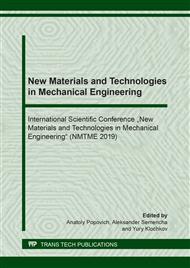[1]
Hiroto Kitaguchi (September 19th 2012). Microstructure-Property Relationship in Advanced Ni-Based Superalloys, Metallurgy, Yogiraj Pardhi, IntechOpen,.
DOI: 10.5772/52011
Google Scholar
[2]
Travyanov AY, Petrovskiy PV, Turichin GA, Zemlyakov EV, Kovac M, Vondracek S, Kondratiev A, Khvan AV, Cheverikin VV, Ivanov DO, Bazhenova IA. Prediction of solidification behaviour and microstructure of Ni based alloys obtained by casting and direct additive laser growth. Materials Science and Technology. 2016 May 23;32(8):746-51.
DOI: 10.1179/1743284715y.0000000134
Google Scholar
[3]
Sufiyarov V.Sh., Borisov E.V., Polozov I.A., Masailo D.V. Control of structure formation in selective laser melting process. Tsventnye Metally. 2018. No. 7. pp.68-74.
Google Scholar
[4]
Sufiyarov V.Sh., Popovich A.A., Borisov E.V., Polozov I.A. Selective laser melting of heat-resistant Ni-based alloy. Non-ferrous Metals. 2015. No. 1. pp.32-35.
Google Scholar
[5]
Turichin GA, Klimova OG, Babkin KD, Pevzner YB. Effect of thermal and diffusion processes on formation of the structure of weld metal in laser welding of dissimilar materials. Metal science and heat treatment. 2014 Jan 1.
DOI: 10.1007/s11041-014-9671-7
Google Scholar
[6]
Lopota VA, Turichin GA, Valdaitseva EA, Dilthey U, Goumeniuk A. Theoretical investigation and modeling of intermetallic inclusion formation in laser treatment of Al-Mg alloys. InLaser-Assisted Micro-and Nanotechnologies 2003 2004 Apr 2 (Vol. 5399, pp.197-204). International Society for Optics and Photonics.
DOI: 10.1117/12.555548
Google Scholar
[7]
Kovalev OB, Neronov VA. Metal and Chemical Analysis of Reaction Interaction in a Mixture of Nickel and Aluminum Powders. Physics of Combustion and Explosion, 2004, V.4, № 2.
DOI: 10.1023/b:cesw.0000020139.07061.9e
Google Scholar
[8]
Kozubski R., Cadeville M.C. In Situ resistometric investigation on ordered kinetics in Ni3Al/ Phys. F.: Met. Phys.- 1988,- V. 23,- P. 45-48.
DOI: 10.1088/0305-4608/18/12/008
Google Scholar
[9]
Klimova-Korsmik O, Turichin G, Zemlyakov E, Babkin KD, Petrovsky P, Travyanov A. Technology of High-speed Direct Laser Deposition from Ni-based Superalloys. Physics Procedia. 2016 Jan 1;83:716-22.
DOI: 10.1016/j.phpro.2016.08.073
Google Scholar
[10]
Turichin GA, Somonov VV, Babkin KD, Zemlyakov EV, Klimova OG. High-Speed Direct Laser Deposition: Technology, Equipment and Materials. Equipment and Materials. 2016 Apr;125(1):012009.
DOI: 10.1088/1757-899x/125/1/012009
Google Scholar
[11]
Stankevich SL, Korsmik RS, Valdaytseva EA. Modeling of bead formation process during laser cladding. In Journal of Physics: Conference Series 2017 May (Vol. 857, No. 1, p.012045). IOP Publishing.
DOI: 10.1088/1742-6596/857/1/012045
Google Scholar
[12]
Saunders N, Phase Diagram Calculation for Ni-Based Superalloys. TMS, Warrendale, 1996, 101.
Google Scholar


